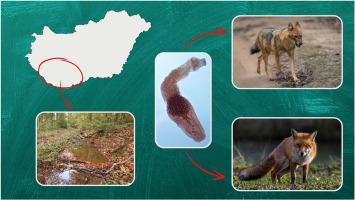Suitability of red fox (Vulpes vulpes) and golden jackal (Canis aureus) as hosts of Echinococcus multilocularis based on egg production characteristics and literature data on the intestinal ecosystems of carnivores
IF 1.7
Q3 PARASITOLOGY
Current research in parasitology & vector-borne diseases
Pub Date : 2024-01-01
DOI:10.1016/j.crpvbd.2024.100225
引用次数: 0
Abstract
Echinococcus multilocularis is the most important food-borne parasite in Europe. Its natural definitive host is the red fox (Vulpes vulpes) while other canid species play a secondary role in the maintenance of its endemics. However, recent studies call attention to the potential of golden jackal (Canis aureus) as a suitable definitive host for E. multilocularis. Our study aimed to evaluate the quantitative and qualitative egg production traits of adult E. multilocularis in different hosts as an indicator of reproductive success. Investigation of 111 and 82 parasites from 33 red foxes and 29 golden jackals, respectively, we ascertained that the proportion of worms with mature eggs was significantly lower in golden jackals than in red foxes. Those worms, which produced mature eggs in golden jackal hosts, originated from less crowded infrapopulations than their fox-originated counterparts. Other characteristics of the parasite’s reproductive ability, such as the proportion of fertile worms, and mean egg production were similar in the two hosts. Comparing these findings to evolutionary data on different canid taxa, we hypothesised that the mutual presence of red fox and a differently evolved host of E. multilocularis might contribute to the formation of stable parasite circulation in these multi-host systems.

根据产卵特征和有关食肉动物肠道生态系统的文献数据,确定赤狐(Vulpes vulpes)和金豺(Canis aureus)是否适合作为多核棘球蚴的宿主
多角棘球蚴是欧洲最重要的食源性寄生虫。它的天然宿主是赤狐(Vulpes vulpes),而其他犬科动物则在维持其特有性方面扮演次要角色。然而,最近的研究表明,金毛豺(Canis aureus)有可能成为多角体圆线虫的合适终宿主。我们的研究旨在评估多角体圆线虫成虫在不同宿主体内产卵的数量和质量特征,以此作为繁殖成功的指标。我们分别对 33 只赤狐和 29 只金毛豺的 111 和 82 个寄生虫进行了调查,结果发现金毛豺的成熟虫卵比例明显低于赤狐。这些在金豺宿主体内产下成熟卵的蠕虫,与狐狸寄生的蠕虫相比,来自较不拥挤的下层种群。寄生虫繁殖能力的其他特征,如可育蠕虫的比例和平均产卵量,在两种宿主中相似。将这些发现与不同犬科类群的进化数据进行比较后,我们推测赤狐与多角体圆线虫的不同进化宿主的共同存在可能有助于在这些多宿主系统中形成稳定的寄生虫循环。
本文章由计算机程序翻译,如有差异,请以英文原文为准。
求助全文
约1分钟内获得全文
求助全文

 求助内容:
求助内容: 应助结果提醒方式:
应助结果提醒方式:


